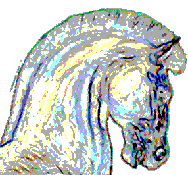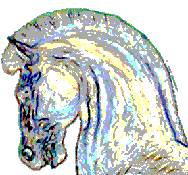| Characteristics |
| The Standardbred is often described as "honest".
He is robust, plain, rugged, capable of performing any job, and is one
of the equine world's best kept secrets. Not only is he the fastest
racing breed in harness, he also excels off the racetrack. He is a
meduim-build horse, ranging in size from 14.2 to 17.2 hands and weighing
900 to 1,200 pounds. Colors are bay, brown, black, chestnut, and
occasionally grey, without spots or patches. |
| Head |
| The head should be well proportioned to the rest of the body,
refined, straight, and chiseled, with a broad forehead, large nostrils,
shallow mouth and small muzzle. The ears should be medium to small in
size, set wide, and active. The eyes should be larger and clear,
reflecting the horse's calm nature. |
| Body |
| The Standardbred has a long, sloping, strong shoulder, long,
high croup, short back and a bottom line that is much longer than the
top line. The chest is deep and thick, and the ribs well-sprung.
Muscling is heavy and long, allowing a long, fluid stride. The neck
should be slightly arched, lean and muscular, and medium-to-long; the
throatlatch clean and the head carried either high or at a moderate
level; the withers well-defined and extending well back beyond the top
of the shoulder. The legs are hard and very correct in their action
with muscling both inside and out. The hocks are wide, deep and clean.
The hooves are large, tough and durable. |
| Action |
| Trotting and pacing are balanced gaits; the horse in action
should appear well balanced front to back. Their trot seems huge
compared to other light saddle breeds, with fairly close hock action and
the hind legs moving up well underneath the horse. Although
Standardbreds are known for their racing gaits, they do canter and this
gait should also be balanced and free-flowing. The "pace" is peculiar
to this breed. Whereas a trotting horse moves its legs in diagonal
pairs, the pacer (or sidewheeler) moves its legs in lateral pairs
similar to a camel. The pace can be easily retrained as a "rack". |
| In early racing, pacers were rare. Today, nine out of ten races are
for pacers. Generally, pacers are faster and accelerate more quickly
than trotters. In general, pacers do not stride as high as trotters,
resulting in less concussion to the foot, more efficient stride, and a
highter top speed. The greater the efficiency of stride, the easier it
is for the horse to acheive maximum speed and the less tiring on his legs
over a greater distance. |
| Temperament |
| The Standardbred is tractable and steady, with great stamina.
He is popular with Civil War reënactment groups because he is
"bombproof" - mock battles with cannons and muskets don't disturb
his equilibrium. He is a willing partner in most endeavors and enjoys
human companionship. He is sadly underrated as a riding horse and can
perform well in jumping, western pleasure or reining, and can be
impressive in dressage. Standards are also used extensively in movies |
| History |
| The founding sire of today's Standardbred was Messenger, a grey Thoroughbred
brought to America in 1788 by Thomas Benger and later sold to Henry
Astor, brother of John Jacob Astor. |
| Messenger was a direct descendent of
the Darley Arabian, one of the founding sires of the Thoroughbred. His
sire, Mambrino, was one of the best race horses of his day; the master
of four-mile heats. Mambrino was grand in size and immensely strong,
and founded a dynasty of famous trotting coach horses in England.
Messenger stood at stud for twenty seasons in New Jersey, Pennsylvania,
and New York. Messenger sired many great Thoroughbreds, including
Miller's Damsel, who produced American Eclipse, who in turn sired
Whirlaway, Gallant Fox, and Man O'War, horses known for their trotting
action, speed, and gameness. |
| Descendants of Messenger soon dominated the race courses of America.
Among them was Topgallant, a Philadelphia livery stable hack who was
first seen trotting in perfect form alongside a galloping runaway.
He went on to racing fame, at one time winning a four-mile, four-heat
race - sixteen miles in all. |
| There were other racers who started as working horses. Dutchman pulled a delivery
truck for a brickyard; Lady Suffold was the first trotter to pull a
wagon around the mile in 2:30 - at the age of twelve. |
| Harness Racing |
| In 1879, the term Standardbred was introduced to distinguish those trotting
horses who met a certain "standard" for the mile distance. The horses
were clocked in .25 seconds until 1940,when all times were recorded in
fifths. The current standard for two-years-olds is 2.20 minutes, and
for three-year-olds the standard is 2.15 minutes. The standard distance
is always one mile. |
| Race horses will have record of pedigrees and also their racing statistics.
These can seem confusing at first, but are very easy to read once you
know the rules. A pedigree is like a human family tree and reads the
same way. The first name will be of the horse; the second set of names
will be the parents; third, the grandparents, etc. The bottom (or left)
line of all pedigrees is the dam; the top (or right) line is sire. For
example: |
|
Camtastic |
|
Lushkara |
Cam Fella |
|
Perta Hanover |
Albatross |
Nan Cam |
Most Happy |
|
Pert Dottie |
Tar Heel |
Voodoo Hanover |
Meadow Skipper |
Nan Frost |
Bret Hanover |
Laughing Girl |
Meadow Skipper |
|
| Statistics on a horse off the track might look like this: |
| Sea Whisper (Sparkling Speed x Nakia) 1981 m t 2:03f $63,049 |
| This says that a trotting (t) mare (m) named Sea Whisper, whose father (sire)
is Sparkling Speed and whose mother (dam) is Nakia, was born in 1981.
Her fastest winning effort (at one mile) was two minutes, three seconds
on a five-eights mile track and she won $63,049. A "TT" preceding the
record would indicate that the record was taken in a time trial rather
than a race. The initial following the record indicates the size of
the racing oval (m for mile, f for five-eights, h for half-mile). The
standard distance is always one mile. |
| The United States Trotting Association |
| USTA is the governing body of the Standardbred horse. Everyone buying a
Standardbred for racing or breeding purposes must become a member of
USTA. The horse's registration papers are duly transferred upon
approval of membership. USTA also offers services for non-racing
and non-breeding owners. |
| The Standardbred Equestrian Program (SEP) is an ambitious, multi-faceted
program designed to promote the Standardbred in all disciplines. |
| A new and exciting sport is Standardbred "Racing Under Saddle" (RUS).
Started in 1996, this sport could revitalize Standardbred racing
on the west coast. This sport is sanctioned by USTA, takes place
on a race track, and riders are licensed. Requirements for licensing
include being over 16 years old, a member of USTA and having the
ability to demonstrate experience with equestrian sports. There are
no weight restrictions on riders. To date, 75 percent of those applying
for licenses are women. The horses follow the starting gate just as in
harness racing, then race for one mile, all at a trot or pace. |
| USTA offers a database that will provide past racing and pedigree information,
where available. The SEP activities database will issue an "Activities
Certificate" for any horse that can be identified by its tattoo, and
will document horse's accomplishments in non-traditional use. |
| SEP assists adoption programs in placing horses off the track by offering
space on the Internet. |
| You can get more information by contacting the Standardbred Equestrian
Program at USTA. The address is 750 Michigan Avenue, Columbus, OH
43215-1191; telephone (614) 224-2291 or FAX (614) 224-4575 or on the
Web at www.ustrotting.com. |
There is also a Trotting Horse Museum (P.O.Box 590, Goshen, NY 10924)
which offers books, videos and great trotting horse gifts. For a
gift catalog, or membership application form, call (914) 294-6330
before 5 PM (EST) any day.
|


